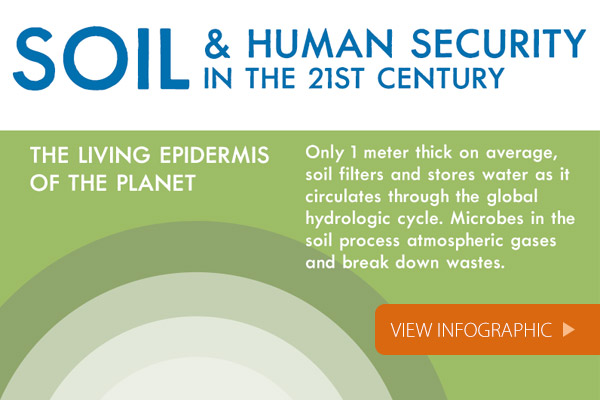Soil security
Article in journal Science outlines threats to soil productivity
3:16 p.m., May 7, 2015--A group of leading soil scientists, including the University of Delaware’s Donald L. Sparks, has summarized the precarious state of the world’s soil resources and the possible ramifications for human security in a paper published Thursday, May 7, in the journal Science.
In a review of recent scientific literature, the article, titled “Soil and Human Security in the 21st Century,” outlines threats to soil productivity — and, in turn, food production — due to soil erosion, nutrient exhaustion, urbanization and climate change.
Research Stories
Chronic wounds
Prof. Heck's legacy
“Soil is our planet’s epidermis,” said Sparks, echoing the opening line of the article. “It’s only about a meter thick, on average, but it plays an absolutely crucial life-support role that we often take for granted.”
Sparks, who is the S. Hallock du Pont Chair in Soil and Environmental Chemistry in the Department of Plant and Soil Sciences at UD, has been chair of the National Academy of Sciences’ U.S. National Committee for Soil Sciences since 2013.
He and his five co-authors, who are also members of the national committee or leaders of soil science societies, wrote the paper to call attention to the need to better manage Earth’s soils during 2015, the International Year of Soils as declared by the United Nations General Assembly.
“Historically, humans have been disturbing the soil since the advent of agriculture approximately 10,000 years ago,” Sparks said. “We have now reached the point where about 40 percent of Earth’s terrestrial surface is used for agricultural purposes. Another large and rapidly expanding portion is urbanized. We’re already using the most productive land, and the remainder is likely to be much less useful in feeding our growing population.”
As the population of the planet grows toward a projected 11 billion people by 2100, the key to producing enough food will be to find better ways to manage the agricultural lands we already have, Sparks says, rather than expanding into new areas. However, this will mean overcoming some rather daunting challenges.
According to the Sparks and his colleagues, soil erosion greatly exceeds the rate of soil production in many agricultural areas. For example, in the central United States, long considered to be the “bread basket” of the nation, soil is currently eroding at a rate at least 10 times greater than the natural background rate of soil production.
The loss of soil to erosion also involves the loss of key nutrients for plant growth, leading to the need for commercial fertilizers. However, the current rate of fertilizer production is unsustainable, according to Sparks.
“The evidence for this is in the recent spike in the price of fertilizers,” he said. “The primary components of fertilizer are either very energy-intensive to produce or they are mined from limited supplies on Earth. It’s a classic supply-and-demand situation leading to large price increases that must eventually be passed on in the price of food.”
Sparks says the increase in fertilizer prices is not likely to be temporary. The largest reservoir of rock phosphate in the U.S. is expected to be depleted within 20 years, he says, at which point we will need to begin importing this source of the essential nutrient phosphorus.
“Unless we devise better ways to protect and recycle our soil nutrients and make sure that they are used by crops efficiently rather than being washed away, we are certainly headed for nutrient shortages,” Sparks said, adding that disruptions in food production could become a source of geopolitical conflict.
“Human civilizations have risen and fallen based on the state of their soils,” Sparks said. “Our future security really depends on our ability to take care of what’s beneath our feet.”
For an informational graphic, click here.
About Don Sparks
In addition to chairing the U.S. National Committee on Soil Sciences, Donald L. Sparks has been president of both the Soil Science Society of America and the International Union of Soil Sciences. He was recently awarded the 2015 Geochemistry Division Medal from the American Chemical Society, the first soil scientist to receive this honor.
He is the author of 225 research papers, 55 book chapters and 12 books and has advised 90 graduate students and postdocs. He is the director of the Delaware Environmental Institute at the University of Delaware, where he has taught and conducted research for 37 years, and has received the University’s highest academic honor, the Francis Alison Award.
Article by Beth Chajes
Graphic by Jeff Chase
Photo by Evan Krape












